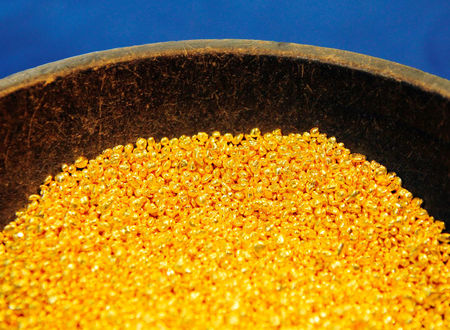Commodities
Gold prices struggle around $2,400; Copper battered by China woes

Investing.com– Gold prices moved little in Asian trade on Tuesday, hovering around 11-day lows as traders sought more clarity on U.S. politics and monetary policy, especially ahead of a Federal Reserve meeting next week.
Among industrial metals, copper prices fell on Tuesday, extending steep losses in recent sessions amid growing economic uncertainty over top copper importer China.
rose 0.1% to $2,398.38 an ounce, while rose 0.2% to $2,399.40 an ounce by 00:33 ET (04:33 GMT).
Gold tumbles from record highs; rate cuts, politics in focus
The yellow metal was nursing a sharp drop from record highs over the past week, as uncertainty over U.S. politics weighed.
Spot prices had surged to around $2,470 an ounce earlier in July, before pulling back sharply. Some resilience in the , amid speculation over a Donald Trump presidency, also weighed on bullion prices.
Uncertainty over the U.S. presidential race rose this week after President Joe Biden withdrew his reelection bid, and instead endorsed Vice President Kamala Harris. Harris was seen gaining enough Democratic delegates to become the party’s presidential nominee, although she is yet to be formally nominated.
Still, Trump was seen polling ahead of Biden and Harris, according to CBS and HarrisX polling data from last week. But polls are yet to reflect the impact of Biden’s dropping out.
While this political uncertainty fueled some safe haven flows into gold, resilience in the dollar limited these flows.
Still, gold was sitting on strong gains this year, amid growing optimism that the Federal Reserve will begin cutting interest rates from September. The central bank is set to and is widely expected to keep rates steady then.
Other precious metals retreated on Tuesday. fell 0.1% to $959.65 an ounce, while fell 0.5% to $29.188 an ounce.
Copper nurses steep losses as China sentiment worsens
Among industrial metals, benchmark on the London Metal Exchange rose 0.2% to $9,234.50 a tonne, while one-month fell 0.3% to $4.1873 a pound.
Both contracts were at over 3-½ month lows as worsening sentiment towards top importer China sparked deep losses in the past week.
Data from China showed economic growth slowed in the second quarter, with an unexpected interest rate cut on Monday doing little to lift spirits.
The Chinese Communist Party’s Third Plenum yielded scant details from Beijing on plans for more economic support.
Concerns over stricter U.S. monetary policy, stemming from a potential Trump presidency, also kept traders wary of China-exposed assets.
Commodities
Oil prices rise; U.S. crude inventories plunge, Russia-Ukraine truce eyed
Commodities
India’s Reliance to stop buying Venezuelan oil over US tariffs, sources say
Commodities
Oil prices climb on Venezuela supply worries

 Forex3 years ago
Forex3 years agoForex Today: the dollar is gaining strength amid gloomy sentiment at the start of the Fed’s week

 Forex3 years ago
Forex3 years agoUnbiased review of Pocket Option broker

 Forex3 years ago
Forex3 years agoDollar to pound sterling exchange rate today: Pound plummeted to its lowest since 1985

 Forex3 years ago
Forex3 years agoHow is the Australian dollar doing today?

 Cryptocurrency3 years ago
Cryptocurrency3 years agoWhat happened in the crypto market – current events today

 World3 years ago
World3 years agoWhy are modern video games an art form?

 Commodities3 years ago
Commodities3 years agoCopper continues to fall in price on expectations of lower demand in China

 Economy3 years ago
Economy3 years agoCrude oil tankers double in price due to EU anti-Russian sanctions























